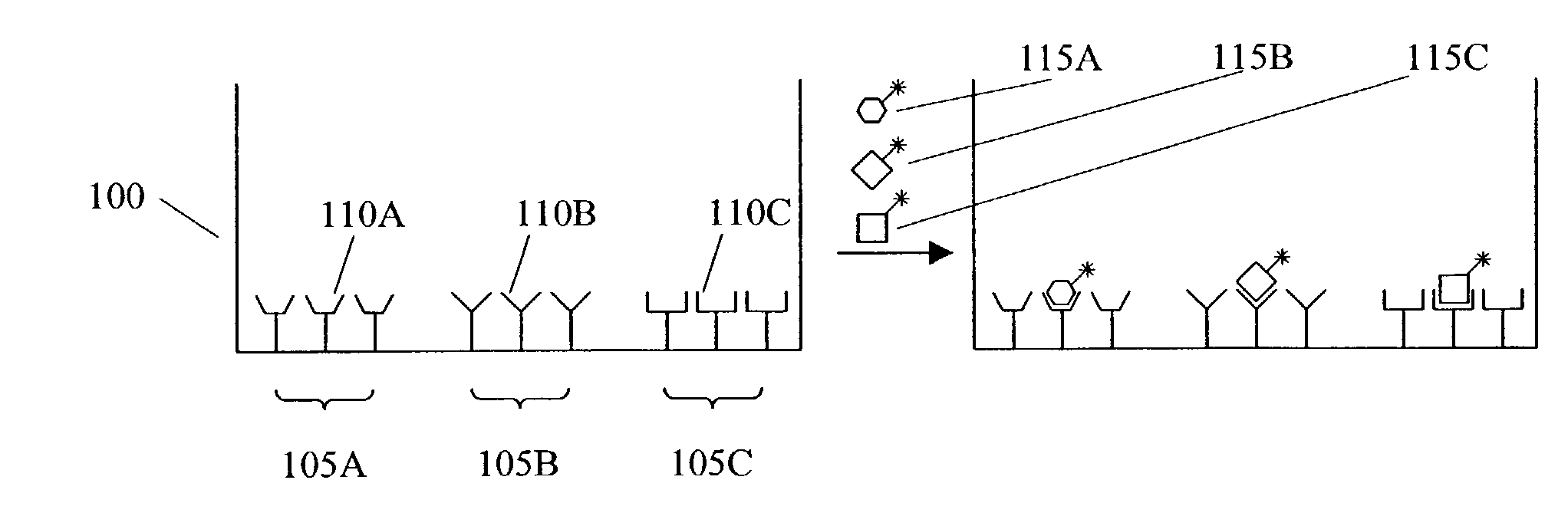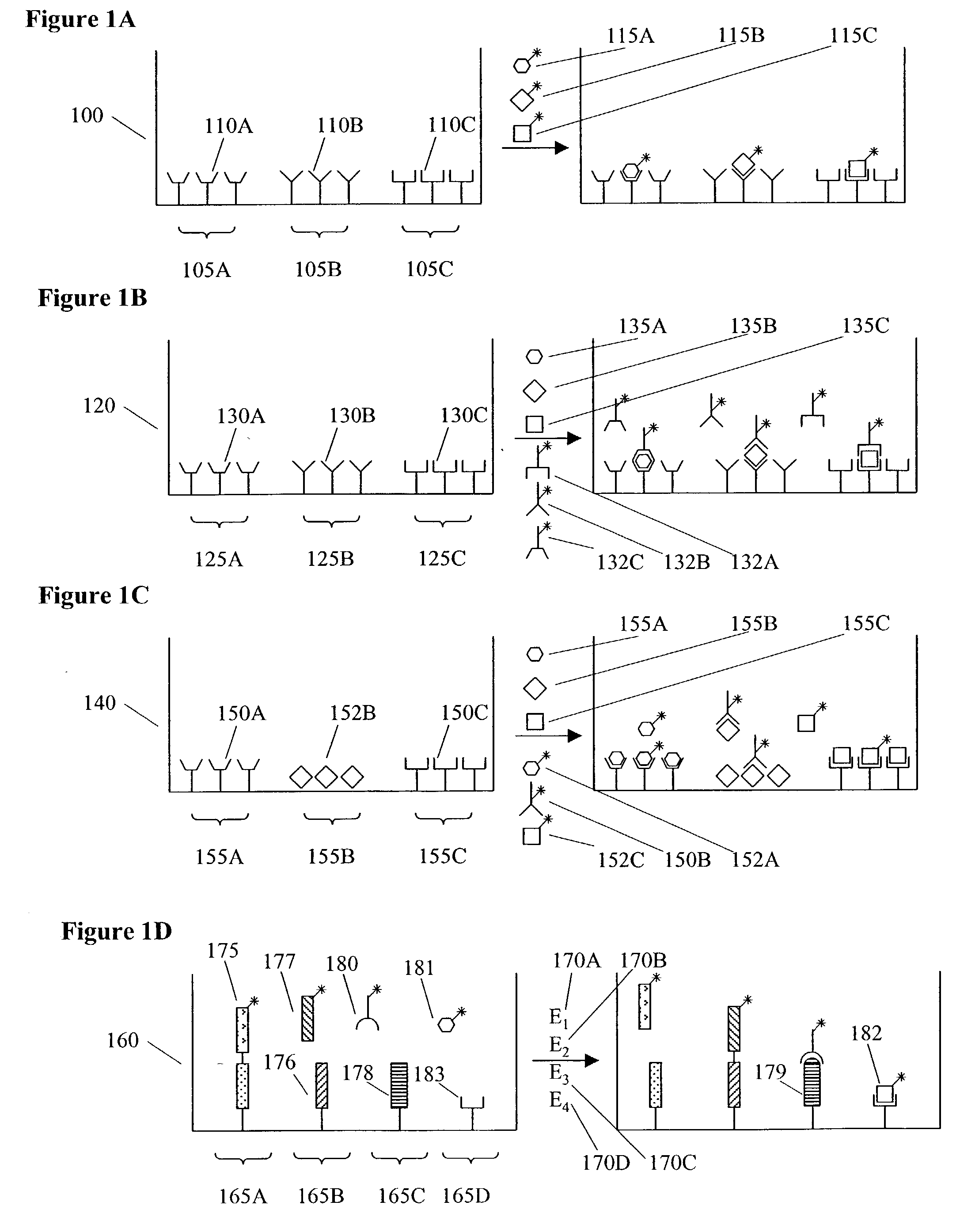Methods and apparatus for conducting multiple measurements on a sample
- Summary
- Abstract
- Description
- Claims
- Application Information
AI Technical Summary
Benefits of technology
Problems solved by technology
Method used
Image
Examples
example 1
Fabrication of Multi-Well Assay Plates Having Screen Printed Electrodes
[0183] Multi-layer plate bottoms were prepared by screen printing electrodes and electrical contacts on 0.007" thick Mylar polyester sheet. The Mylar sheet was first cut with a CO.sub.2 laser so to form conductive through-holes (i.e., holes that were subsequently made conductive by filling with conductive ink) as well as to form alignment holes that were used to align the plate bottom with the plate top. Electrical contacts were formed on the bottom of the Mylar sheet by screen printing an appropriately patterned silver ink layer (Acheson 479ss) and a carbon ink overlayer (Acheson 407c). The carbon ink layer was dimensioned slightly larger (0.01 inches) than the silver ink layer to prevent exposure of the edge of the silver film. Working and counter electrodes were formed on the top of the Mylar film in a similar fashion except that three layers of carbon ink were used to ensure that no silver remained exposed. T...
example 2
ECL Measurements
[0186] Plates were read on an instrument designed to make electrical contact to individual square sectors. The sector in electrical contact with the instrument was aligned with a telecentric lens (having a front element with a diameter of 4.1 ") coupled to a cooled CCD camera (VersArray: 1300F, Princeton Instruments) that was used to image ECL emitted from the sector. The camera employed a CCD chip with dimensions of roughly 2.6 cm.times.2.6 cm and having a 1340.times.1300 array of pixels. The pixel size was 0.02 mm.times.0.022 mm. An optical band pass filter in the optical path was used to select for light matching the emission profile of ruthenium-tris-bipyridine. A translation table was used to translate the plate under the telecentric lens so as to allow all 6 sectors to be read. Image analysis software was used to identify wells or assay domains within wells and to quantitate ECL from specific wells or domains. ECL from plates having screen printed carbon workin...
example 3
An ECL Assay Measuring Multiple Activities of an Enzyme in One Well of an MDMW Plate
[0187] Many nucleic acid processing enzymes have both nucleic acid synthesizing (e.g., polymerase or ligase) activities and nuclease activities. One example is HIV Reverse Transcriptase (RT), an enzyme with both a RNA-dependent DNA polymerase (RDDP) activity and an RNAse H activity. The following example demonstrates an ECL assay for measuring both HIV RT activities in one well of an MDMW Plate.
[0188] The assay format is illustrated in FIG. 12. The enzyme substrate is a 5'-labeled (using TAG phosphoramidite, IGEN International, Inc.) DNA primer bound to the 3'-end of an RNA target sequence. The RDDP activity extends the DNA primer to make a complementary copy of the RNA sequence. The RNAse H activity selectively hydrolyzes RNA in RNA-DNA duplexes. RNAse activity is measured by hybridizing the labeled DNA product to an immobilized probe (3'-B13) that is complementary to the DNA primer sequence (thus m...
PUM
| Property | Measurement | Unit |
|---|---|---|
| Concentration | aaaaa | aaaaa |
| Size | aaaaa | aaaaa |
| Ratio | aaaaa | aaaaa |
Abstract
Description
Claims
Application Information
 Login to View More
Login to View More - R&D
- Intellectual Property
- Life Sciences
- Materials
- Tech Scout
- Unparalleled Data Quality
- Higher Quality Content
- 60% Fewer Hallucinations
Browse by: Latest US Patents, China's latest patents, Technical Efficacy Thesaurus, Application Domain, Technology Topic, Popular Technical Reports.
© 2025 PatSnap. All rights reserved.Legal|Privacy policy|Modern Slavery Act Transparency Statement|Sitemap|About US| Contact US: help@patsnap.com



